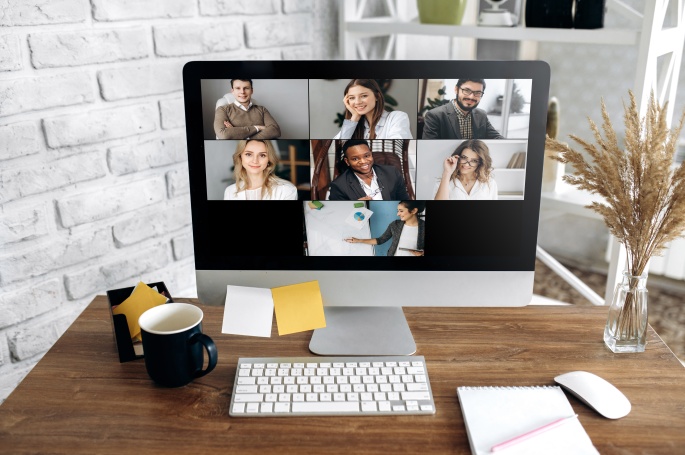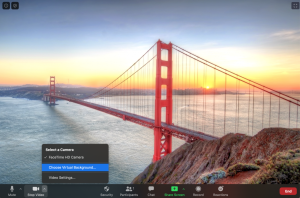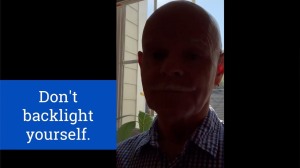
Most coaching has always been done remotely, primarily via telephone. Nowadays coaches and clients hold many, if not most, of their sessions via some form of video conferencing platform. Zoom, GoTo Meeting and many other apps and services allow us to coach clients all around the globe. What fun it can be to have clients on several continents, and perhaps others just across town, yet see them “live”.
Reviewing video session of coaches and their clients in action has led me to some interesting observations. There are definitely some ways in which coaches must be very conscious about how they are conducting such sessions. Here are some tips for how to Zoom it up and still do your best coaching.
Coaching Presence
 • Look at the camera
• Look at the camera
While telephonic coaching sessions allow you to look at your notes, let your eyes wander, etc., you have to treat a video session like an in-person meeting. Would you ask a question with your head turned down and to the side in-person? Remember your client is (or may be) looking to the screen and is naturally seeking eye contact just like in all other visual human interactions. Look at where your camera lens is located on your device, not on the eyes of your client on the screen. The bigger the device – like a desktop computer – the more the gap between the two. Even when your client is looking all over the place, keep your coaching presence as “live and in-person” as possible.
 • Be aware of your surroundings.
• Be aware of your surroundings.
No, this is not a street safety warning, it’s about the background of your coaching setting. Your client wants a professional coach, not someone coaching in their bedroom with an unkempt bed visible behind the coach. Now, of course coaches long ago discovered that working from home is a great way to hold down costs. If you don’t have a room that is either suitably neutral or professional looking you have a few options. 1) Go with a background screen (lots available online). 2) Use a virtual background. Virtual backgrounds however have some drawbacks visually. If you move a bit, the back of you head may go into that science fiction warp speed look. You’ve all seen this before and know how distracting it can be. 3) Convert an area of your dwelling into a proper looking space for your video sessions.
• Dress the part

Dress like a pro. Dress for success. Business casual will do fine. Ditch the tee-shirt. Why is this important? Like your “office” surroundings, appearances convey a sense of competence and reliability, which combined with compassion are the three building blocks of trust. You want your clients to be able to trust you with personal and sensitive information. They may be struggling with lifestyle improvement goals that are vital to their health, wellbeing, or even their survival. Think of it this way. If you would like to get referrals from medical professionals, would you like them to see you conducting a session that had a “super-informal” look? It is all part of your Coaching Presence.
• Anticipate potential disturbances
Dealing with interruptions isn’t easy. Working at home can easily collide with other members of the household, both two-legged and four-legged. While most clients are quite understanding and forgiving of the occasional interruption, you’ll want to do your best to keep your “office” boundaries in force. When such things become more than rare/occasional, clients can lose faith in your professionalism.
Let There Be Light!
Back-lit coaches lose their visual advantage for conveying coaching presence. Light needs to be in front of you illuminating your smiling face well. Harsh, glaring lights will wear you out if you have a few sessions back to back. You don’t have to invest in hundreds of dollars of studio lighting; however, you do need to project an image that is quite adequately illuminated. Warm toned lights convey a more relaxed and, well, warm image.
Request the same of your client. Kindly let them know that your ability to see them well can aid you in your coaching. It’s certainly is easier to pick up on visual changes in expression when you can see a person’s face adequately.
To Zoom or Not to Zoom
• The wandering camera
Not all of the responsibility for a great coaching session via video conferencing falls on the shoulders of the coach. A client may be doing sessions with you on their phone’s video as they continually walk all around their apartment, holding the phone at all angles, moving it very frequently. I can remember working with a mentee of mine where we were both fighting vertigo as we attempted to watch such a video recording! As the client continued moving, they kept distracting themselves and not being very present in the coaching conversation. When the coach requested that they continue their coaching via phone only – with no video, the effectiveness of their coaching actually improved. Both client and coach could concentrate better.
 The Visual Aspect of Nonverbal Communication
The Visual Aspect of Nonverbal Communication
A coach’s listening skills depend upon keen observation. We are constantly scanning all that we hear and see. While we can pick up on all of the nuances of vocal communication over a phone (volume, tone, rapidity, pitch, shifts), the video allows us to augment that with the visual cues we are able to see and observe. While the client’s camera is usually showing us only upper body and facial imagery, this helps our observation tremendously. Here are a couple of tips for working with this.
• Shifts
Observing any shifts in nonverbal behavior is key. Is there a change in expression or posture as the topic shifts?
• Patterns
Are there any repetitive patterns in the visual nonverbal behavior and are such patterns related to anything in the content of the session?
• Congruence
Is there congruence or incongruence between what the client is saying, and the emotion being conveyed nonverbally? For example, a client who smiles again and again when they speak of a painful subject.
• Take your observations and either share them or store them
Sharing observations is a true coaching skill. The key is to share observable behavior, not your interpretations. Simply feed your observation back to your client with a phrase such as “Are you aware that…” or “Are you aware of…”. You can also ask permission to share an observation. Storing observations may be the choice you make depending upon the usefulness of sharing it in the moment or saving it for later. You may want to stow it away in what I call your “listening day pack” and bring it out when you have noticed a repetition or pattern of the same behavior.
Video conferencing platforms have enhanced our ability to both reach more clients (globally!) and have visual advantages that telephonic coaching can’t provide. Let it work to make your coaching better than ever.
 Michael Arloski, Ph.D., PCC, NBC-HWC is CEO and Founder of Real Balance Global Wellness – a world leader in health and wellness coach training. (www.realbalance.com). Doctor Arloski is a pioneering architect of the field of health and wellness coaching. He and his company have trained thousands of coaches around the world. His latest book is Masterful Health & Wellness Coaching: Deepening Your Craft. https://wholeperson.com/store/masterful-health-and-wellness-coaching.html
Michael Arloski, Ph.D., PCC, NBC-HWC is CEO and Founder of Real Balance Global Wellness – a world leader in health and wellness coach training. (www.realbalance.com). Doctor Arloski is a pioneering architect of the field of health and wellness coaching. He and his company have trained thousands of coaches around the world. His latest book is Masterful Health & Wellness Coaching: Deepening Your Craft. https://wholeperson.com/store/masterful-health-and-wellness-coaching.html
